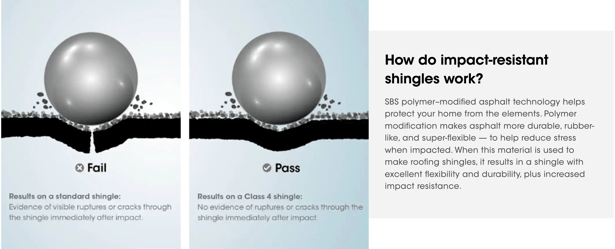Share this
Class 4 IR Shingles vs. Standard Shingles: Making an Informed Choice
by Michael Wilhelm on Aug 29, 2023 10:44:48 AM
.png?width=1920&height=1280&name=Class%204%20vs.%20Standard%20(1).png)
Introduction
When selecting the right roofing material for your home, the decision can be pretty impactful. Two popular contenders in the roofing world are Class 4 Impact Resistant (IR) shingles and standard shingles. Class 4 IR shingles are known for their robust durability and impact resistance, while regular shingles offer versatility and affordability. In this blog post, we're diving into the advantages and trade-offs of each option, empowering you to make a well-informed decision tailored to your roofing needs.
Class 4 Impact Resistant Shingles: Unparalleled Strength
Imagine having a roof that can brave even the harshest weather conditions. That's precisely what Class 4 IR shingles provide – exceptional resilience in the face of challenges. These shingles have undergone rigorous testing to meet specific impact resistance standards set by reputable organizations like Underwriters Laboratories, who drop a 2" steel ball twice from a 20-foot height onto various target locations to evaluate the shingles' ability to withstand the impact.
 UL 2218 Class 4 Impact-Resistance Test [Source: GAF.com]
UL 2218 Class 4 Impact-Resistance Test [Source: GAF.com]
Benefits of Class 4 Shingles:
Exceptional Durability
Class 4 IR shingles are constructed using a reinforced fiberglass mat and specialized asphalt composition. This combination creates an exceptionally durable roofing material that protects your home from various external forces.
Superior Impact Resistance
One of the key advantages of Class 4 shingles is their ability to withstand hail, falling debris, and other impacts more effectively than regular shingles. This resilience reduces the risk of damage and potential leaks, providing homeowners peace of mind.
Extended Warranties
Manufacturers often offer extended warranties for Class 4 IR shingles, reflecting their confidence in the product's longevity and performance. These warranties can be especially reassuring in unforeseen circumstances.
Potential Insurance Savings
Many insurance companies recognize the enhanced performance of Class 4 IR shingles and may offer premium discounts to homeowners with this type of roofing material. This can lead to long-term financial savings on insurance premiums.
Trade-offs of Class 4 Shingles:
Higher Initial Cost
The durability and enhanced composition of Class 4 IR shingles come at a higher initial cost than standard shingles. Expect an increase of approximately 15-20% in expenses.
Regional Climate Considerations
While Class 4 IR shingles excel in regions prone to severe weather, they might be overkill in milder climates. Evaluating your specific climate conditions is essential for making the right choice.
Limited Aesthetic Options
Class 4 IR shingles may have fewer aesthetic options compared to standard shingles. However, manufacturers continually expand their design offerings to cater to diverse preferences.
Regular Shingles: Versatility and Affordability
On the flip side, standard shingles provide homeowners with a versatile and budget-friendly option.
.png?width=615&height=410&name=Standard%20Shingles%20(1).png)
Benefits of Standard Shingles:
Affordability
Standard shingles are generally more cost-effective than Class 4 IR shingles, making them suitable for homeowners with specific budget constraints.
Design Versatility
With a wide range of colors, styles, and shapes, standard shingles offer homeowners the flexibility to match their roofing material with their home's architectural style.
Easy Installation and Maintenance
Standard shingles are familiar to roofing contractors, leading to straightforward installation and maintenance processes.
Trade-offs of Regular Shingles:
Limited Impact Resistance
Unlike Class 4 IR shingles, standard shingles are more vulnerable to hail or falling debris impacts. This could lead to damage and the need for repairs, especially in areas prone to severe weather events.
Shorter Lifespan
Due to their composition, regular shingles could have a shorter lifespan than Class 4 IR shingles. This could result in the need for replacement sooner, increasing long-term costs.
Reduced Warranty Coverage
Manufacturers could offer shorter warranties for standard shingles compared to Class 4 IR shingles. This might leave homeowners with less protection against unexpected roofing issues.
Potential for Higher Insurance Costs
Since standard shingles have lower impact resistance, homeowners may be slightly more likely to file insurance claims for roof repairs. This could potentially lead to higher insurance costs over time.
Limited Extreme Weather Performance
Standard shingles might not provide the same level of protection in regions with extreme weather conditions like frequent hailstorms or heavy winds. This could result in more frequent repairs or replacements.
Choosing the Right Roofing: Balancing Strength and Cost-Effectiveness
In conclusion, selecting between Class 4 IR shingles and standard shingles requires careful consideration of the benefits and drawbacks of each choice. If you're seeking remarkable durability and impact resistance, Class 4 IR shingles might be the answer. On the other hand, standard shingles offer versatility and cost-effectiveness. Remember, the choice hinges on your needs, budget, and preferences. Consulting with roofing professionals can provide valuable insights, ensuring your roofing decision aligns with your home's long-term protection and peace of mind.
And in the meantime, check out the GAF Residential Reference Guide. This comprehensive guide will provide you with even more valuable information to help you decide which roofing material is right for your home. Whether you're looking for unparalleled strength and durability or versatility and affordability, the GAF Residential Reference Guide covers you. So don't miss out on this valuable resource – check out the guide today and discover all that these roofing options have to offer.



No Comments Yet
Let us know what you think